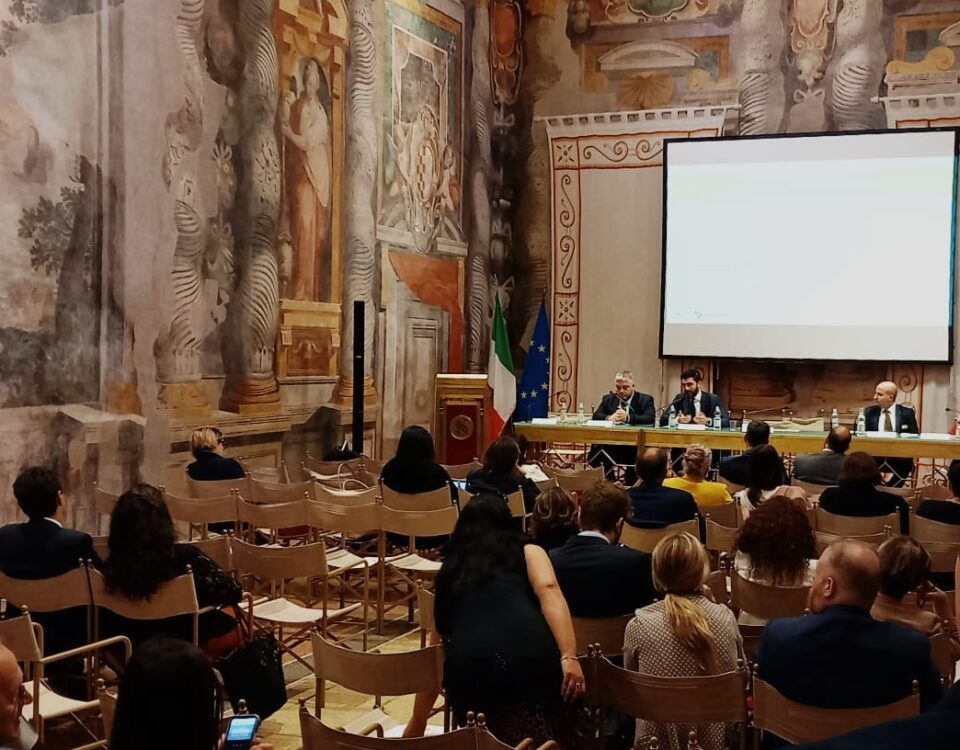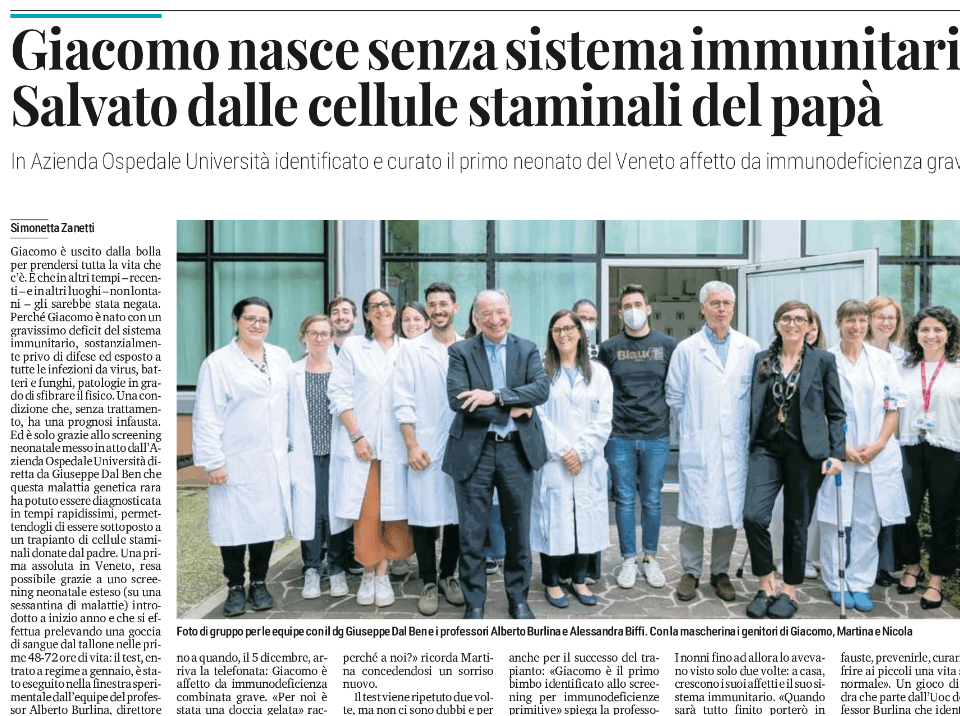Contro i rischi dei farmaci una rete europea di farmacisti ospedalieri
1 Aprile 2005Autistic children’s abnormal metabolic profile findings
3 Aprile 2005Full Stem Ahead
“Researchers pursue a controversial technique intended to cure diseases by transplanting custom-made cells
Christen Brownlee
In many ways, 9-year-old Jacob Sontag is much like his fourth grade classmates. He loves reading, watching movies, and listening to music, and he’s well liked by a large circle of friends. However, Jacob is not a typical boy. He has Canavan disease, a rare neurodegenerative disorder that has gradually depleted the myelin, or electrical insulation, in his brain and confined him to a wheelchair. Jacob and his family are looking to a controversial experimental approach to cure him someday.
We hear a lot of talk about the hope and the promise of stem cells,” says Jacob’s mother, Jordana Holovach.
Jacob’s doctor, neuroscientist Paola Leone of the Robert Wood Johnson Medical School in Camden, N.J., says that if today’s early research pans out, stem cells transplanted into the boy’s brain eventually might replace the myelin-producing cells that he lacks.
Researchers seeking cures for many other medical conditions—including type-1 diabetes, Parkinson’s disease, osteoporosis, and heart disease—are also looking to stem cell transplants for cures.
Stem cells’ essential nature—their capacity to grow into more than one of the body’s 300-odd cell types—has many scientists buzzing about possibilities of treating disease in entirely new ways and of revealing secrets of the body’s early development. Over the past 5 years, researchers have performed numerous experiments with stem cells collected from embryos and mature tissues—called embryonic and adult stem cells, respectively. However, for this approach to reach its full potential, problems with the cells’ tricky biology must be overcome. Many researchers also say that the government is hindering scientific advances with stem cells by setting limitations on laboratory use of human embryos.
“The promise [of stem cells] has not been exaggerated,” says Charles Jennings, executive director of the Harvard Stem Cell Institute in Cambridge, Mass. “What’s been lost in discussion is how long it will take and how difficult it will be” for stem cells to live up to their billing, he says.
From one, many
Stem cells possess two qualities that other cells simply don’t have. First, they haven’t committed themselves to being any one cell type, such as skin, liver, or muscle. Second, stem cells can multiply many times—some can multiply indefinitely—making progeny that retain this blank slate property or that adopt a cell type in the appropriate circumstances.
While all stem cells are uncommitted, some have fewer options than others, most researchers say. For example, an adult liver stem cell will become some brand of liver cell but not a kidney cell.
In contrast, the fertilized egg is the most versatile stem cell. During normal development, it gives rise to all the cell types of the placenta and body.
After the fertilized egg, embryonic stem cells are the most flexible stem cell type. Once a fertilized egg has gone through several rounds of division, stem cells form a bulge, called the inner cell mass, inside the early embryo. These cells can create any cell in the body, although they can’t differentiate into placental tissue. Some evidence suggests that umbilical cord blood and fetal stem cells are just as versatile as embryonic stem cells.
For scientists interested in using stem cells to replace damaged or depleted cells—such as the myelin-producing cells that Jacob lacks—it’s often pivotal to coax stem cells to differentiate into the right tissue type before they’re transplanted. In animal experiments, stem cells transplanted into the body before they’re differentiated sometimes form a cancerous tumor made of a mishmash of different tissue types.
The body’s native stem cells differentiate on their own in response to chemical messages. Once such a signal turns on a group of genes, the cells follow a one-way path to becoming a particular tissue. For instance, signals sent out by wounded skin tissue alert adult stem cells to turn into new skin cells.
In the lab, making stem cells differentiate into predictable cell types has proved difficult, especially for embryonic cells, which have been isolated from people only since 1998.
“Stem cells are a dynamic, living system. Making them into what you want them to be is almost like trying to herd cats,” says Philip Schwartz of Children’s Hospital in Orange, Calif.
Schwartz explains that researchers have a few tricks for pushing cells into a preferred type. For example, scientists can dose cells with various growth-promoting proteins to mimic the instructions normally provided within the body. However, this frequently leads to an unpredictable mix of differentiated cells, with just a small percentage being the type that researchers were aiming for. Then, the scientists have to either take difficult extra steps to isolate the right cells or abandon their experiment.
The challenge of getting stem cells to differentiate reliably in the lab, says Schwartz, is to provide the cells with an identical replica of the chemical signals that the body naturally uses to sway adult and embryonic cells to differentiate. “The problem is, we don’t know what [those signals] are yet,” he says. Identifying such signals is a central focus of Schwartz’ lab and many others.
Cellular healing
Luckily, some adult stem cells save researchers the task of sorting cells or guessing chemical signals. After being transplanted into the body, these stem cells automatically differentiate into specific tissue types.
For decades, researchers have taken advantage of this quality in treating leukemia patients with bone marrow stem cells, which differentiate into white blood cells and various other components of the circulatory system after transplantation.
Many scientists are now expanding this notion beyond blood products. Recent research has uncovered populations of adult stem cells in many tissues, including the liver, lungs, brain, and even the teeth. The cells are especially prevalent in tissues that are in vulnerable parts of the body that must continually be repaired or replaced, such as skin. Scientists predict they’ll eventually find stem cells in almost every tissue—giving researchers the opportunity to repair these parts of the body using a person’s own cells.
Some work using adult stem cells is already under way. For example, Douglas Losordo of Tufts University in Boston and his colleagues have treated heart patients with boosted doses of their own stem cells. Research had shown that stem cells from bone marrow circulating in the blood, could differentiate into the cells that make up blood vessels. New blood vessels, says Losordo, could provide alternative paths for circulation in patients with clogged arteries.
Losordo’s team worked with patients with partially or wholly blocked coronary arteries. Currently, most people with this condition have a range of treatment options, such as arterial stents, angioplasty, or coronary bypass, but the patients in Losordo’s study hadn’t responded positively to any of these conventional treatments. “They were the sickest of the sick,” says Losordo.
In their recent experiment, the researchers first administered granulocyte-colony stimulating factor, a drug that boosts the output of stem cells in bone marrow. They then repeatedly drew blood from the patients and collected a subset of the bone marrow stem cells known as CD34-positive cells, which have a propensity to differentiate into blood vessels. Once a person’s stem cell collection reached a critical mass, the researchers injected the cells back into that person.
Losordo and his colleagues are still analyzing the results from this experiment. However, he says that compared with people who received only their own unaltered blood serum, those who received stem cells showed a marked improvement in heart function. In the preliminary tests, patients with the stem cell boost developed new blood vessels that rerouted blood around blocked ones.
According to Losordo, administering a heavy dose of adult stem cells, as he did in this experiment, is tantamount to “giving a booster dose of the natural mechanism for tissue repair.”
Valuable youth
Adult stem cells, however, don’t look promising as of yet to treat some diseases, such as type-1 diabetes. That disease occurs when a person’s immune system destroys pancreas cells called islets of Langerhans, which secrete insulin. Without insulin to control them, blood sugar concentrations can reach damaging or even toxic levels.
“In the pancreas, there isn’t a lot of clear evidence for adult stem cells” that can become islet cells, says Jennings.
Transplants of islet cells from cadavers are already a treatment option for people with type-1 diabetes (SN: 3/5/05, p. 157: Available to subscribers at http://www.sciencenews.org/articles/20050305/note12.asp), but there aren’t enough suitable cadavers to go around, says Luca Inverardi, research professor at the University of Miami. Furthermore, the transplanted cells work for only about 2 years before patients have to go back on insulin, he says.
Inverardi and other researchers are working to overcome those obstacles by getting lab cultures of human embryonic stem cells to produce abundant, long-lasting populations of islet cells in diabetes patients. The first step will be to understand what signals the body uses to turn embryonic cells into insulin-producing cells. Despite several years of effort, the scientists have not yet fully identified these signals.
“When we are able to reproduce this series of events in the lab, then we are likely to have in our hands a potentially unlimited supply of transplantable cells,” he says.
Ole Isacson of Harvard Medical School in Boston says that Parkinson’s disease is also a good candidate for future treatments based on embryonic stem cells. In that disease, brain cells that secrete a neurotransmitter called dopamine gradually die out. Neurons that use the neurotransmitter to control walking, talking, and other motor functions can’t communicate effectively without dopamine, the result is uncontrollable tremors. Some patients’ symptoms became less severe after transplants of fetal-brain tissue that produces dopamine. However, no treatment has permanently fixed the defect.
Scientists have recently discovered adult stem cells in the brain. Unfortunately, early results with brain stem cells haven’t been promising in Parkinson’s research. “We can’t make the [adult stem] cells into the right one to treat Parkinson’s,” says Isacson. “The big argument in neuroscience is, Why don’t you just get the brain to repair itself? Maybe in 50 years someone will figure it out, but right now it’s daunting.”
Therefore, he and other researchers are focusing on embryonic stem cells. In lab dishes, his team has already gotten mouse embryonic cells to change into dopamine-producing brain cells. Transplanting these cells into the brains of rats with symptoms that mimic Parkinson’s disease permanently relieved the tremors of some of the animals, Isacson’s team reported in 2002.
Since then, the group has focused on optimizing its procedure for preparing the stem cells and on defining how well they work after transplant. Because it takes 6 to 7 months for transplanted cells to mature, Isacson says, progress has been slow.
Drawing lines
Promising results are drawing researchers into an ethical morass surrounding embryonic stem cells. To start a new line of embryonic stem cells, researchers destroy a human embryo, often a microscopic ball of cells that had been produced in vitro at a fertility clinic but not used. Opponents of embryonic stem cell research liken this procedure to murder.
Proponents of embryonic stem cell research argue that the early embryo is akin to other human tissues rather than to an independent life. “People have cancerous tumors removed every day, but they don’t hold a funeral over them,” says Ruth Faden, a bioethicist at Johns Hopkins University in Baltimore.
In response to these dilemmas, current federal guidelines for funding embryonic research strike a difficult balance. These guidelines, announced by President Bush on August 9, 2001, limit funding from the National Institutes of Health to embryonic stem cell lines—then thought to number about 60—that had been established before that date. “I have concluded that we should allow federal funds to be used for research on these existing stem cell lines, where the life-and-death decision has already been made,” Bush said at the time.
These guidelines were more stringent than the Clinton administration’s 1999 recommendations to permit federal funding for any lines established from “spare” embryos at fertility clinics.
Isacson and other researchers who work with animal embryonic cells aren’t affected by these federal funding restrictions. However, says Sue O’Shea, who works with stem cells at the University of Michigan Medical School in Ann Arbor, many researchers are being limited in their research by the government’s policy.
Since the current restrictions were put into place, the number of approved cell lines has fallen to 22. The federally approved lines are “tremendously difficult” to keep alive, says O’Shea. They were created without the aid of recent technologies that make many of the newer—unapproved—stem cell lines hardier.
The restrictions are also expected to limit the medical applications of approved research. All the approved lines were grown on a layer of mouse cells, a medium that somehow keeps the cells from differentiating, but recent research suggests that they’re contaminated by mouse proteins and viruses and, therefore, are unsuitable for transplanting into people.
Additionally, some researchers have found that many of the approved cell lines have their own troublesome quirks. For example, a biotechnology company has coaxed embryonic stem cells to become retinal cells, a discovery that could treat certain types of blindness. The team used a cell line that it had developed independently. “We tried to apply that same research to several of the presidentially approved stem cell lines, and it didn’t work,” says Robert Lanza and his colleagues at Advanced Cell Technology of Worcester, Mass.
O’Shea points out that embryonic stem cells are not only valuable to basic research but also potentially useful as therapeutic tools. The cells are ideal for studying the processes that go on in embryonic development. O’Shea, for example, is looking at embryonic stem cells to investigate how the early nervous system develops.
Understanding how tissues form could help researchers prevent or cure some types of birth defects and adult disorders, she says.
With all that promise, what’s a researcher to do if the approved stem cells aren’t adequate for a particular embryonic stem cell study? Maybe move to California. A recently passed bill known as Proposition 71 will grant $300 million of taxpayer funds over the next 10 years to support embryonic stem cell research. Several other states are considering legislation that would fund such work, and many countries around the globe encourage stem cell research.
Despite the legal and biological challenges, Jennings is optimistic about this research. “Stem cells are a fundamental fact of biology—that’s been made clear in the past few years,” he says. “There’s tremendous potential here. Stem cells are not just a passing fad.”
“




